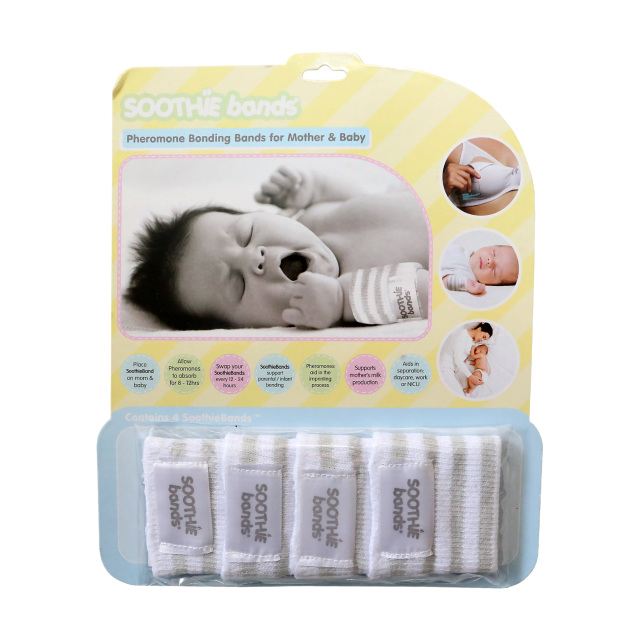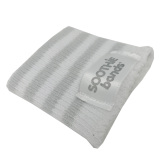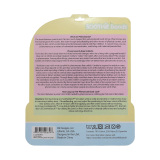PheroBands
Pherobands promote parent/child bonding during separation. Hospitalized infants in mother/baby, NICU, or pediatric units wear the bands after parent has worn in bra or on their body to collect pheromones, skin cells, and even let down from breastfeeding mothers. PheroBands™ hope to promote psychosocial care and support imprinting process during hospitalization.
The mother-infant bond produced by pheromones is one that begins in the womb and is carried out as long as both mother and child are alive. While humans do not generally readily admit the work of pheromones in their lives, not wanting to admit any animalistic characteristics, it is hard to dispute that pheromones are just as active in humans as they are in nonhumans. From an infant identifying his or her mother’s scent when only a few days old, to a youth who identifies a mother he never knew, pheromones are constantly at work within all of us.
Fiber: 5% cotton , 30% polyester,25% elastic
Care: Machine wash warm in delicates bag. Wash as needed. Do not bleach. Air dry.
How do Soothie Bands work?
The bond between mother and child are much deeper than just emotional heart strings. Pheromones are exchanged in the womb, through breastfeeding, and through other means of physical contact which create a lifelong bond between mothers and their children. We use pheromones as a means of nonverbal communication and maternal ties.
How Long Can the Pheromone Bond Last?
This bond between a mother and child created by pheromones is not limited to a mother and her infant. It is a lifelong tie that cannot be broken. Pheromones also serve as identifiers. Mothers and children can recognize each other by the pheromones each emits.
Where Does the Bond Begin?
Pheromones begin their mother-infant connection before the baby is ever born. While children are in the womb, they begin recognizing their mother’s pheromones:
While hugged in the cozy, wet warmth of the womb, the fetus uses pheromones to communicate with its mother in a quiet code of chemical signals. This chemical link survives the baby’s birth so that a mother can identify her infant not only by his smell but also by his pheromones. Pheromones also help guide the infant’s mouth toward the nourishment of his mother’s breast. (Kodis, 1998, p.13)
The olfactory sends messages to the growing fetus so that by the time the baby is born, he or she has spent the past several months getting to know the mother’s pheromone chemistry.
What Role Does Breastfeeding Play?
Breastfeeding plays a major part in the passing of pheromones from mother to child. It does not take a child very long to learn and become partial to his or her mother’s pheromones. “At six days – some researchers say three days – awake babies can discriminate between their mother’s breasts and strange women based solely on their pheromones” (Kohl & Francoeur, 1995, p.78).
Which Glands Are Involved?
Not only are the pheromones associated with breastfeeding important for a baby’s survival, breastfeeding also allows the baby to be exposed to his or her mother’s underarm pheromones. “Nursing at the breast exposes the infant to maternal pheromones from apocrine and sebaceous glands in the underarms and in the dark tissue around the nipples” (Kohl & Francoeur, 1995, p.79). These glands have secretions which make up a person’s body scent when mixed with bacteria living on the skin. “After birth, bacteria on the infant’s skin convert the adrenal androgens from the sebaceous and apocrine secretions into the characteristic body odor of newborns” (Kohl & Francoeur, 1995, p.142). Also, during pregnancy, these glands ensure that the infant fully develops.
At birth, male babies get a surge of GnRH which results in a LH surge. This is apparently triggered by exposure to the mother’s pheromones. The LH surge keeps the testes pumping out a high level of testosterone which further masculinizes the brain by destroying or altering connections between nerve cells and creating male circuits. (Kohl & Francoeur, 1995, p.96)
How Do Pheromones Influence Infants?
A breastfed infant reaps more benefits than just being able to recognize his or her mother’s breast pheromones. “Breast-fed infants also recognize their mother’s underarm pheromones, while bottle-fed do not” (Kohl & Francoeur, 1995, p.78).
There is a chemical known as oxytocin which, according to Michelle Kodis, is the “cuddle chemical. ” (Kodis, 1998, p.96) “When a mother hears her hungry baby cry, oxytocin intervenes, making her nipples erect and ready to pass the stream of milk so desired by the infant” (Kodis, 1998, p.96). This response ensures that the mother wants to nurse her baby as much as the baby wants her milk.
How Do Pheromones Benefit the Mother?
Pheromones are not only for the benefit of children; mothers also rely heavily on the unmistakable pheromones of their offspring. “Odors help mothers bond to and identify their own infants. Human mothers, for example, regularly brush their noses into their baby’s hair so they can inhale its sweet odor as they cuddle it” (Kohl & Francoeur, 1995, p.128).
How Long Can the Pheromone Bond Last?
This bond between a mother and child created by pheromones is not limited to a mother and her infant. It is a lifelong tie that cannot be broken. Below is a phenomenal story of the extent of this pheromonal bond:
A woman was visiting Oxford, England, when she found her world turned on end. She was standing by a river when a group of young male students walked by. As the boys passed, the woman had the unmistakable and instant feeling that one of these youths was the infant son she had given up for adoption only a few hours after his birth. The young man said later that he had experienced a similar visceral, gut reaction to the female “stranger” standing by the water. As he walked by, a thought flew into his brain: That’s my mother! (Kodis, 1998, pp.12-13)
The thing that makes this story even more amazing is that, according to Kodis (1998), there were no physical similarities that could have signaled to either person that the other might be related to them. It was strictly on the pheromonal bond created in the womb between this mother and her child that they recognized each other as mother and son.







